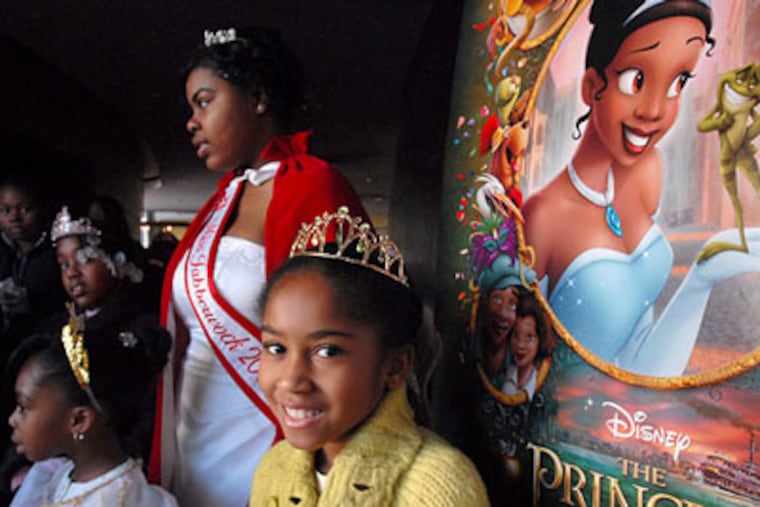Annette John-Hall: 'The Princess and the Frog' at the Bridge
After last weekend's very special screening of The Princess and the Frog, you have to wonder if there was a single tiara left in Philadelphia.

After last weekend's very special screening of The Princess and the Frog, you have to wonder if there was a single tiara left in Philadelphia.
That's because glittery half-crowns graced the heads of hundreds of little girls, mostly African American, who flocked to the Bridge in University City Saturday dressed in their princess finery for a film first that befitted their royal attire.
After all, there has never been an African American princess portrayed in a Disney film in its 86 years. That is, until Tiana - the beautiful and plucky heroine in The Princess and the Frog, which led the box office over the weekend, grossing more than $25 million.
"The first of the first black princesses!" gushed Karla McJunkin, 42, of Mount Airy, who sounded as if she enjoyed the film as much if not more than her 10-year-old daughter, Shayla. "I gave it a 10."
Yes, Tiana's positive self-image is affirming for us moms, too. Finally, we have an undeniably brown-skinned princess with full lips, round hips, and a Southern lilt that sounds like my favorite cousin.
"Sleeping Beauty, Snow White. I mean, I watched them, but now I can say I couldn't relate to them," says Tanita Kidane, 42, of University City, who came with her 11-year-old daughter, Rebecca. "I used to wear towels on my head to make it seem like I had long hair. . . . It's hard not to have a role model."
Even if the image reflected nothing more than a standard of beauty, America's notion of it was seldom of a darker hue. Which was why Delta Sigma Theta, the African American women's sorority, jumped at the chance to host special screenings all over the country.
With the black community abuzz over the Lee Daniels drama Precious, the nightmarish tale of a poor, dark-skinned, 350-pound 16-year-old who is physically and sexually abused by her mother and impregnated by her father - a film that presents every bottled-up urban pathology there is - the uplifting images and message of The Princess and the Frog come at just the right time.
"The magnitude of this is something you probably won't see for years to come," says Charlotte Wroton, 48, who brought goddaughters Heaven and Astarte McNeill with her. "Movies touch children at this age."
Charles Gallagher, professor of sociology at La Salle University, agrees: "Children internalize values. Disney can do in an hour and a half what parents can't even approach."
The Princess and the Frog is the inspirational story of Tiana, a young working-class woman living in the cultural gumbo of 1919 New Orleans who is "as pretty as a magnolia in May." Even a handsome prince can't derail her dream of owning her own restaurant, no matter that it looks like her dream is dashed after she is mistakenly smooched and turned into a frog by freeloading Prince Naveen.
She later realizes nothing is as important as love, and self-love - even the prospect of living life as a frog.
Of course, it's only when she loses everything that she understands what's really important, and her dream of restaurant ownership comes true. The extra added? A prince - who learns to be appreciative of a strong, independent woman.
Yes, Tiana is a frog through most of the movie, which garnered Disney some criticism. But after seeing it, I understood that Tiana had to take a leap of faith as a frog to get her ultimate reward.
"I liked that she was a frog because losing everything made her reflect on everything she really needed," Kidane said. "I loved the message."
The film may be set in 1919, but its message is uniquely postmodern and no doubt one that all mothers tell their own daughters.
It's also one that particularly resonates with African Americans. I'm guessing most black women heard the kind of self-reliance lecture I got from my mother, who hammered home the importance of education and career: "Always put aside something for yourself. Don't depend on no man to take care of you."
As with everything Disney, the film has come with its share of giddy commercialism.
The yearlong anticipation of Disney's first African American princess caused merchandise to fly off shelves - everything from Princess Tiana Halloween costumes to Princess Tiana-themed hair products by Carol's Daughter, a New York-based beauty products company Disney licensed to sell Princess Tiana products, which sold out in seven hours.
Oh, and good luck trying to find a Princess Tiana doll, this year's hot Christmas item.
Of course Tiana, with her deep-brown doe eyes, raven hair, and yes, tiara, could not help but be a model of beauty to little black girls everywhere. But the stronger message of independence and entrepreneurship will hit home for girls of every color.
"I liked that she didn't give up her dream, because some people do give it up when they think it's too hard," said Astarte McNeill, 12.
Sounds like somebody with big plans.
"I have a dream of being a veterinarian," McNeill says. "I've had it since I was little."
And for other girls, Prince Charming wasn't the end-all, but rather icing on the cake.
"I like the fact that in the end, she got everything she went after, after all her hard work," said Heaven McNeill, 14. "And she got the prince, too."